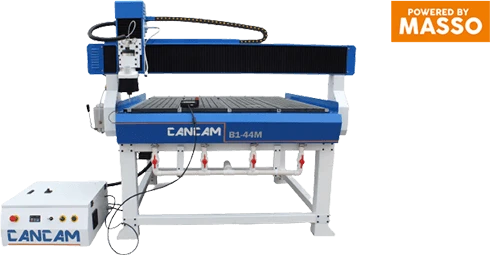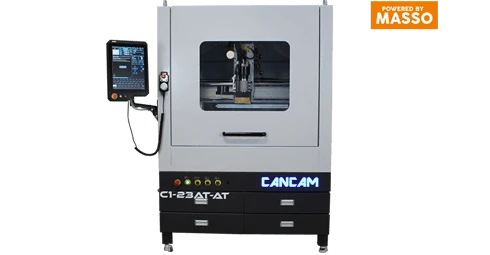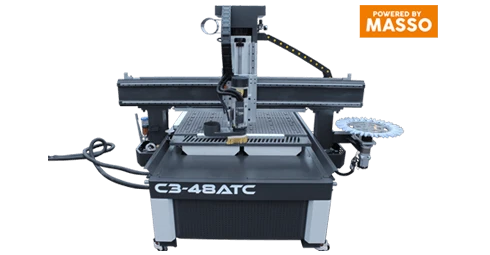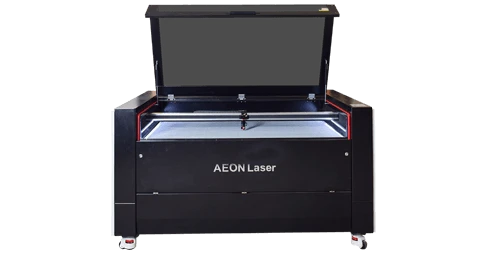Glossary
Absolute Coordinates
Absolute coordinates are expressed relative to a fixed position, whereas relative coordinates are expressed relative to the cutting tool’s current position.
Accuracy
Accuracy is the difference between the desired and actual dimension of a measurement.
Auto Tool Changer (ATC)
An auto tool changer (ATC) switches between multiple toolheads without stopping the production cycle for additional setup.
Axes (x-axis, y-axis, z-axis)
An axis is an imaginary line used to measure distances and describe positions within a cartesian coordinate system. The X-axis and Y-axis are typically parallel to the ground (horizontal) and perpendicular to each other. The Z-axis is typically perpendicular to both the X-axis and Y-axis (vertical).
Ballscrew
Ballscrews drive an axis of a CNC machine using a leadscrew and ball bearings for low friction, high efficiency, precision motion.
Block
A block is the smallest unit of G-Code representing an operation that a CNC machine could perform. Printed, a block is represented as a line of text.
Boring
Boring is the process of enlarging a pre-existing hole using a single-point tool.
Cartesian Coordinate System
A cartesian coordinate system uniquely describes each location in a plane with a pair of numbers measured in the same unit of length. Named for philosopher and mathematician Rene Descartes.
Chamfer
A chamber is beveling applied to smooth an edge.
Chip
Chips are unwanted pieces material removed during manufacturing, especially metal.
Collet
A collet is a kind of clamp used to hold a tool or workpiece during manufacturing.
Computer Assisted Design (CAD)
Computer Assisted Design (CAD) is the use of computer software to design objects to be manufactured.
Coordinates
Coordinates are sets of numbers that describe positions within a defined space.
Computer-Aided Manufacturing (CAM)
Computer-Aided Manufacturing (CAM) is the use of computer software to control machine tools in the manufacturing of workpieces.
Cycle Time
Cycle time is the duration a machine works on a single part.
Deflection
Deflection is the shift in position or vibration of a workpiece due to insufficient hold, which can cause inaccuracy.
Depth of Cut (DOC)
Depth of cut (DOC) refers to the amount of material removed on each pass of the tool.
Dimension
A dimension is the measurement specified in the design document for a feature of a part.
Drilling
Drilling is the process of penetrating the surface of a workpiece with a multi-point tool to make a round hole.
Emergency Stop (E-STOP)
An emergency stop (E-STOP) is a switch that, when activated, immediately halts all machine motion and prevents the machine from running.
Feedrate
Feedrate measures the motion of the tool relative to the workpiece during cutting, whereas speed mesures how fast the spindle rotates the cutting tool.
Frame
The frame is the structural component of a CNC machine that supports all compontents related to linear motion, securing workpieces, and spoilboards.
Gantry
The gantry is a structural component of a CNC machine that travels along one horizontal axis and supports the spindle as it travels along the perpendicular horizontal axis.
G-Code
G-Code is a programming language used by CNC machines to describe and execute various motions through a defined geometrical space. G-Code also defines various offsets and sub-routines, like tool changes.
Jogging
Jogging is the manual operation that causes the machine to move along an axis.
Limit Switch
Limit switches signal when the machine has reached the farthest position along an axis.
Linear Guide Rail
Linear guide rails provide a straight track for low-friction high-precision motion.
Machine Zero (home)
Machine zero (home) is the farthest positive position along each axis.
Offset
An offset is a pre-defined distance used by the CNC controller to account for variable like tool length and wear.
Origin
The origin is the point from which a set of coordinates references its position. For absolute coordinates, the origin is a fixed location, whereas relative coordinates usually reference the current location.
Part Program
A part program is the series of numerical instructions the CNC machine uses to produce a specific part.
Relative Coordinates
Relative coordinates describe a position with reference to a non-fixed origin point, whereas absolute coordinates reference a fixed origin point.
Repeatability
Repeatability is the ability of a CNC machine to accurately reproduce a part continuously.
Router
A router is a tool used to hollow out an area in the face of a workpiece.
Servomotor (servo)
A servomotor is an actuator allowing for motion with precise control of position, velocity, and acceleration.
Setup
Setup is the process of preparing the CNC machine and workpiece for production, including securing the workpiece and installing tools.
Shroud
The shroud is a guard or barrier that wraps around the tool, often attached to a dust collector.
Speed
Speed is the rate at which the spindle turns the cutting tool.
Spindle
The spindle is a motor that turns the cutting tool.
Spoilboard
A spoilboard is the replaceable table surface which allows the cutting tool to pass through the workpiece without damaging the machine’s frame.
Stepper Motor
A stepper motor rotates through a set number of discrete steps based on how many electrical pulses it receives. Similar to a servo, but with less precise motion.
Tool Offset
A tool offset is the pre-defined measurement of the distance between the position of the spindle and the cutting edge of the tool along the Z-axis.
Tool Path (toolpath)
The tool path is the series of coordinates the machine moves through to complete an operation.
Touch Off
Touch off is the process of defining the position of a workpiece or tool length by touching the tool to the workpiece or a known location.
Trial Run (dry run)
A trial run (dry run) executes the part program without any part in the machine to confirm the tool path.
T-Slot
T-slot table surfaces provide standardized aluminum tracks that accept various fasteners (clamps, etc.) to secure the workpiece.
USB
USB, or universal serial bus, is a common port standard used to transfer data from various storage devices, including thumb drives and PCs.
Vacuum Pump
Vacuum pumps provide suction to secure workpieces during manufacturing.
Workpiece
The workpiece is the object being manufactured and/or the stock material used to manufacturer it.








